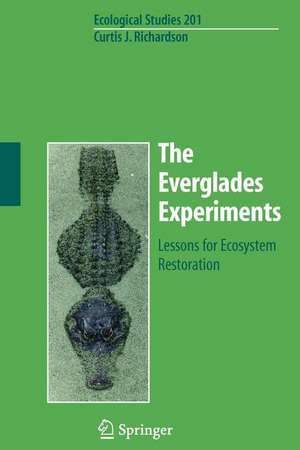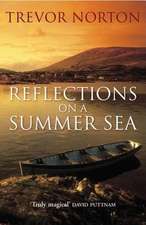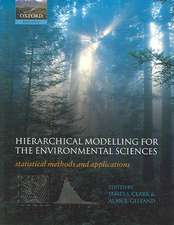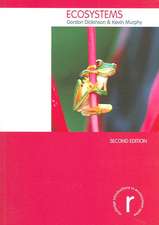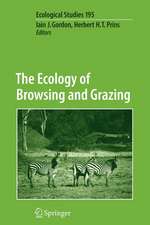The Everglades Experiments: Lessons for Ecosystem Restoration: Ecological Studies, cartea 201
Autor Curtis Richardsonen Limba Engleză Paperback – 23 noi 2010
| Toate formatele și edițiile | Preț | Express |
|---|---|---|
| Paperback (1) | 1236.69 lei 43-57 zile | |
| Springer – 23 noi 2010 | 1236.69 lei 43-57 zile | |
| Hardback (1) | 1242.03 lei 43-57 zile | |
| Springer – 16 apr 2008 | 1242.03 lei 43-57 zile |
Din seria Ecological Studies
- 18%
 Preț: 1118.93 lei
Preț: 1118.93 lei -
 Preț: 553.71 lei
Preț: 553.71 lei - 18%
 Preț: 1680.55 lei
Preț: 1680.55 lei - 18%
 Preț: 1003.38 lei
Preț: 1003.38 lei - 20%
 Preț: 1004.69 lei
Preț: 1004.69 lei -
 Preț: 480.62 lei
Preț: 480.62 lei - 5%
 Preț: 752.26 lei
Preț: 752.26 lei - 15%
 Preț: 643.99 lei
Preț: 643.99 lei - 15%
 Preț: 644.18 lei
Preț: 644.18 lei - 15%
 Preț: 652.49 lei
Preț: 652.49 lei - 18%
 Preț: 789.83 lei
Preț: 789.83 lei -
 Preț: 382.36 lei
Preț: 382.36 lei - 15%
 Preț: 643.48 lei
Preț: 643.48 lei - 15%
 Preț: 646.30 lei
Preț: 646.30 lei - 15%
 Preț: 634.32 lei
Preț: 634.32 lei -
 Preț: 384.86 lei
Preț: 384.86 lei - 18%
 Preț: 789.98 lei
Preț: 789.98 lei - 15%
 Preț: 645.14 lei
Preț: 645.14 lei - 15%
 Preț: 649.39 lei
Preț: 649.39 lei - 18%
 Preț: 1005.43 lei
Preț: 1005.43 lei - 18%
 Preț: 949.23 lei
Preț: 949.23 lei - 15%
 Preț: 649.54 lei
Preț: 649.54 lei - 15%
 Preț: 643.34 lei
Preț: 643.34 lei - 15%
 Preț: 649.71 lei
Preț: 649.71 lei - 15%
 Preț: 638.76 lei
Preț: 638.76 lei - 18%
 Preț: 957.62 lei
Preț: 957.62 lei - 18%
 Preț: 1235.25 lei
Preț: 1235.25 lei - 18%
 Preț: 962.18 lei
Preț: 962.18 lei - 18%
 Preț: 949.23 lei
Preț: 949.23 lei - 15%
 Preț: 660.68 lei
Preț: 660.68 lei -
 Preț: 397.76 lei
Preț: 397.76 lei - 15%
 Preț: 638.24 lei
Preț: 638.24 lei - 18%
 Preț: 942.31 lei
Preț: 942.31 lei - 18%
 Preț: 1232.57 lei
Preț: 1232.57 lei - 15%
 Preț: 651.34 lei
Preț: 651.34 lei - 18%
 Preț: 952.72 lei
Preț: 952.72 lei - 18%
 Preț: 1834.27 lei
Preț: 1834.27 lei - 18%
 Preț: 1229.10 lei
Preț: 1229.10 lei -
 Preț: 423.95 lei
Preț: 423.95 lei - 18%
 Preț: 948.92 lei
Preț: 948.92 lei
Preț: 1236.69 lei
Preț vechi: 1508.16 lei
-18% Nou
Puncte Express: 1855
Preț estimativ în valută:
236.66€ • 245.58$ • 197.81£
236.66€ • 245.58$ • 197.81£
Carte tipărită la comandă
Livrare economică 17-31 martie
Preluare comenzi: 021 569.72.76
Specificații
ISBN-13: 9781441931658
ISBN-10: 1441931651
Pagini: 720
Ilustrații: XVIII, 702 p. 249 illus.
Dimensiuni: 155 x 235 x 38 mm
Greutate: 0.99 kg
Ediția:Softcover reprint of hardcover 1st ed. 2008
Editura: Springer
Colecția Springer
Seria Ecological Studies
Locul publicării:New York, NY, United States
ISBN-10: 1441931651
Pagini: 720
Ilustrații: XVIII, 702 p. 249 illus.
Dimensiuni: 155 x 235 x 38 mm
Greutate: 0.99 kg
Ediția:Softcover reprint of hardcover 1st ed. 2008
Editura: Springer
Colecția Springer
Seria Ecological Studies
Locul publicării:New York, NY, United States
Public țintă
ResearchCuprins
Everglades Ecosystem.- Overview of Gradient Studies and Experiments.- Ecological Status of the Everglades: Environmental and Human Factors that Control the Peatland Complex on the Landscape.- Soil Characteristics of the Everglades Peatland.- Vegetation and Algae of the Everglades Fen.- Nutrient and Hydrologic Gradient Studies.- to the Gradient Studies.- Enrichment Gradients in WCA-2A and Northern WCA-3A: Water, Soil, Plant Biomass, and Nutrient Storage Responses.- Geologic Settings and Hydrology Gradients in the Everglades.- Effects of Hydrologic Management Decisions on Everglades Tree Islands.- Macrophyte Community Responses in the Everglades with an Emphasis on Cattail (Typha domingensis) and Sawgrass (Cladium jamaicense) Interactions along a Gradient of Long-Term Nutrient Additions, Altered Hydroperiod, and Fire.- Algal Responses to Long-Term Nutrient Additions.- Macroinvertebrate Responses to a Gradient of Long-Term Nutrient Additions, Altered Hydroperiod, and Fire.- Historical Changes in Water Quality and Vegetation in WCA-2A Determined by Paleoecological Analyses.- Carbon Cycling and Dissolved Organic Matter Export in the Northern Everglades.- Everglades Experiments.- to a Mesocosm Approach for Establishment of Phosphorus Gradient Experiments.- Water Quality, Soil Chemistry, and Ecosystem Responses to P Dosing.- Macrophyte Slough Community Response to Experimental Phosphorus Enrichment and Periphyton Removal.- Decomposition of Litter and Peat in the Everglades: The Influence of P Concentrations.- Experimental Assessment of Phosphorus Effects on Algal Assemblages in Dosing Mesocosms.- Macroinvertebrate and Fish Responses to Experimental P Additions in Everglades Sloughs.- Plant Community Response to Long-Term N and P Fertilization.- The Effects of Disturbance, Phosphorus, and Water Level on Plant Succession in the Everglades.- Establishment and Seedling Growth of Sawgrass and Cattail from the Everglades.- Modeling Ecosystem Responses to Phosphorus Additions.- Long-Term Phosphorus Assimilative Capacity (PAC) in the Everglades.- Spatial Distributions of Total Phosphorus and Phosphorus Accretion Rates in Everglades Soils.- An Ecological Basis for Establishment of a Phosphorus Threshold for the Everglades Ecosystem.- Lessons for Restoration of the Everglades.- An Ecological Approach for Restoration of the Everglades Fen.
Recenzii
From the reviews:
"The Everglades experiments is one of the few synthesis books that could be used by policy makers and scientists to adopt strategies for Everglades restoration. … The Everglades experiments: lessons for ecosystem restoration is a great resource to scientists and researchers at different universities, and state and federal agencies that are involved in Everglades restoration. It will be useful to students in the ecology and the environmental fields with the Everglades used as a case example." (Samira Daroub, Ecology, Vol. 90 (2), 2009)
"The Everglades experiments is one of the few synthesis books that could be used by policy makers and scientists to adopt strategies for Everglades restoration. … The Everglades experiments: lessons for ecosystem restoration is a great resource to scientists and researchers at different universities, and state and federal agencies that are involved in Everglades restoration. It will be useful to students in the ecology and the environmental fields with the Everglades used as a case example." (Samira Daroub, Ecology, Vol. 90 (2), 2009)
Notă biografică
About the Author: Curtis J. Richardson is a professor of Resource Ecology at the Nicholas School of the Environment and Earth Sciences, Duke University, and Director of the Duke University Wetland Center in Durham, NC.
Textul de pe ultima copertă
Covering more than 4,300 square miles in Southern Florida, the Everglades are the largest subtropical wilderness in the United States. It has been designated an International Biosphere Reserve, a World Heritage Site, and a Wetland of International Importance, in recognition of its significance to all the people of the world. However, it is apparent that the Everglades have undergone radical changes in both water flow and water quality over the years.
The Everglades Experiments: Lessons for Ecosystem Restoration is a synthesis of the key findings and a summary of the experiments conducted during a fourteen-year period (1989-2003) by the Duke University Wetland Center and its partner institutions. Synthesized by Curtis J. Richardson, the findings are the result of extensive experimental research on the effects of water, nutrients, and fire on the Everglades communities. The research focused on such key questions as:
The Everglades Experiments: Lessons for Ecosystem Restoration is a synthesis of the key findings and a summary of the experiments conducted during a fourteen-year period (1989-2003) by the Duke University Wetland Center and its partner institutions. Synthesized by Curtis J. Richardson, the findings are the result of extensive experimental research on the effects of water, nutrients, and fire on the Everglades communities. The research focused on such key questions as:
- What are the effects of increased nutrient and water inputs on the native plant and animal communities?
- What is the long-term nutrient storage capacity of the Everglades? and
- How can water management in the Everglades be improved to maintain the natural communities?
Caracteristici
Background information about current and historical ecological conditions of the region set the context for reports of long-term research projects. A series of gradient studies determining the effects of hydrology and nutrient changes are presented, followed by field experiments that have tested those findings. Subsequent sections present models for predicting responses to various conditions and analyze the studies and models, focusing on management and restoration of the Everglades. This book will interest professionals and graduate students interested in ecosystems and wetland ecology. Includes supplementary material: sn.pub/extras
